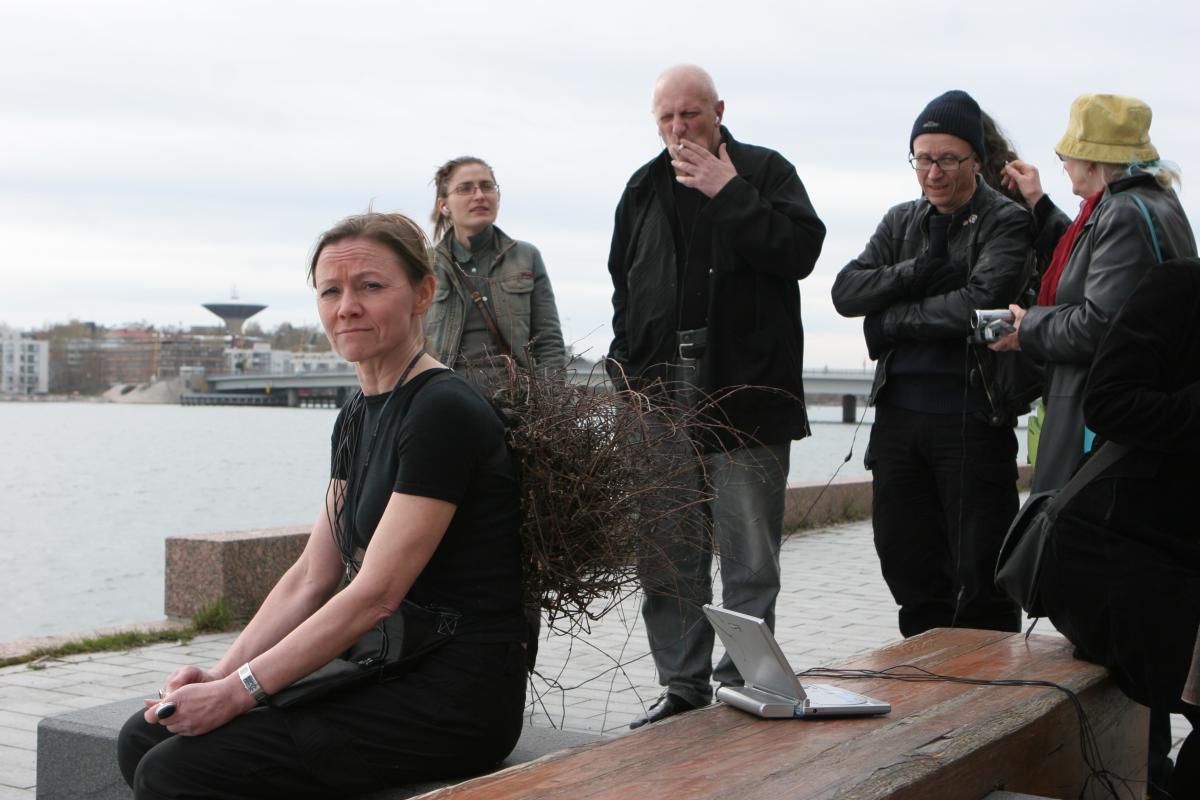The posture of impermanence
An exhibition on live art practices and education in Vantaa Art Museum Artsi, 12.11.2021-23.1.2022.

21st century performance art is defined by redrawing and crossing boundaries, not only through individual authors or works, but also between and within institutions. In this area, performance art retains its special quality because it is a way of doing, a verb, not so much an attribute to be implied in events and actions. Performance art is not really a form of expression between art forms, but an art that consciously challenges boundaries and forms. The change it causes can be a minor move, an unreasonable challenge – or an insurmountable demand. Performance art is both physical and conceptual. You cannot do it without getting bruised or scratched, but at the same time you must ask where, who, how, and what about when the event is finally over? In the practice of performance themes, decisions, and conventions are passed through a body, while the performance makes the world strange. Rather than being something, performance art is more of how to challenge norms.
In a conversation with one of the artists from the forthcoming exhibition, H Ouramo discussed with me the nonbinary stage, the possibility of it. Still, we did not agree, but I feel we shared the notion how performance art is not a representation of the possibility of the nonbinary stage, but it is doing it. It may be also doing something else, at the same time, because performance is not conveying the truth. There is always a posture and simultaneous performativity within — of resistance, disjunction, contradiction or dissolution of ideas and conventions. It is not representational practice, not only, but a performance thinking, at the edge of things and liveness. The nonbinary performance is, as Ouramo suggested, a full space, which we conventionally split in twos. This is only one of the streams that we can pick in performance art practice today, and present in the exhibition “The Posture of Impermanence.”
Performance art and live art are very much alive today. It is better funded than in the early 2000s with secured venues like Mad House and New Performance Turku. But many agents have receded, disappeared, or changed their appearance. The questions that were asked amongst the misbehaving and discordant crowds and performers of the early 2000s are still relevant, but maybe announced in a cooler and more academic manner. Some new ideas and urgent questions have rightly taken centre stage, such as the quest for more inclusive and nonbinary practices, institutions, and structures. Some scathingly say that funding has etiolated the core of performance art into an institutionalized field of no importance: better designed, choreographed, and dramatized, but what’s that got to do with it? The scene has been presented and reviewed in exhibitions and publications, which seem occasionally an attempt to wiggle in some canon, history, or linearity.
Both the exhibition “The posture of impermanence” in the Vantaa Art Museum Artsi (12.11.2021-23.01.2022) and the publication of a book Activating Dissonance: 20 Years of Live Art Education in Finland that celebrates the LAPS anniversary, do not aim for a general purview on performance art today. The exhibition and the book provide rather modest view, orienting towards few points that seem and feel urgent now. The book presents research and articles from curator and researcher Anna Jensen, doctoral candidates and LAPS alumni Nora Rinne and Harriet Rabe von Froreich, exhibition curator Christine Langinauer and LAPS professor Tero Nauha.
The exhibition is a collaborative endeavour with the Vantaa Art Museum Artsi and LAPS MA programme of the Uniarts Helsinki. It presents installations, performances, discussions, site-specific works, media performance and workshops. The artists of the exhibition are Antti Ahonen, Tea Andreoletti, Freja Bäckman, Yun-Chen Chang, Anna Cadia, Dasha Che, Jessica Guez, Harold Hejazi, Fjolla Hoxha, Amanda Hunt, Tina Jeranko, Minerva Juolahti, Essi Kausalainen, Leena Kela, Kemê, Katriina Kettunen, Petros Konnaris, Karolina Kucia, Maija Linturi, James Lórien MacDonald, Stefanía Ólafsdóttir, H Ouramo, Pilvi Porkola, Vishnu Vardhani Rajan, Ladapha Sophonkunkit, Olga Spyropoulou, Onur Tayranoğlu, and Timo Viialainen.
www.uniarts.fi/laps20
www.artsimuseo.com
Exhibition opening 11.11., 18-20
Exhibition opening hours 12.11.2021-23.1.2022, Tue-Wed 11-18, Thu 13-20, Fri 11-18, Sat-Sun 11-16
Performances dates and events on 12.11., 25.11., 4.12., 22.1.2022 (hours TBA on www.artsimuseo.com)
Closing event on 23.1.2022 (hours TBA on www.artsimuseo.com)
When performance
The master’s programme in Live Art and Performance Studies (LAPS) was launched in 2001 as a Finnish-language degree programme, Esitystaiteen ja -teorian koulutusohjelma. Since 2013, LAPS has been an English-language, international and residential MA programme based in Helsinki. The objective of the programme is to enable artists coming from different environments, classes, cultures and upbringings to focus on their work, develop their research and map out the future of their artistic practice. This blog discloses the various aspects of the LAPS programme, from individual notions and statements by students to providing background for LAPS MA thematic interests.
Learn more about the LAPS programme
Latest posts
Follow blog